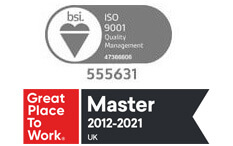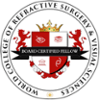The Evolution of Presbyopia Treatment

Declining vision is, unfortunately, an inevitability. Eventually, even those of us lucky enough to have enjoyed perfect vision for our whole lives will find ourselves in need of some sort of correction. In most cases, this will probably mean acquiring a pair of reading glasses – at least at first. But thankfully, over the last few decades, alternative options have been doing away with the need for reading glasses and contact lenses for presbyopia altogether – culminating in the invention of PRESBYOND® Laser Blended Vision.
So, let’s take a look at how treatment techniques for presbyopia (ageing eyes) have developed over the years.
What is Presbyopia?
Presbyopia is a natural part of the ageing process, eventually occurring in 100% of the population. While some of us may be able to hang on to clear vision for a little longer, presbyopia tends to set in around the age of 40. Over time, symptoms will become increasingly obvious as the ability to focus on near objects gradually deteriorates.
This occurs as the eyes’ ability to change focus and zoom from near to distant objects begins to break down. But this process actually begins at a much earlier age. In fact, the crystalline lens in our eyes continues to grow throughout our lives, from birth. However, it is only when we reach middle age that this progressive decline begins to lessen the capabilities of the lens.
At this point, visual aids such as reading glasses or contact lenses will become necessary for close-up tasks such as reading. But as we mentioned at the beginning of this article, several other options are available to correct the effects of presbyopia.
What is the Solution?
Of course, the best solution to presbyopia would be to restore the eyes’ ability to accommodate both near and distance vision. Unfortunately, this has yet to be achieved. While research is ongoing into potential methods to restore the natural focusing mechanism of the eye, it is unlikely that this will culminate in a clinical solution in the next few years.
Thankfully, there are a number of other treatment options that effectively address the primary symptoms of presbyopia. These methods focus on compensating for the lack of accommodation by correcting for both near and distant fields of vision.
The challenge of these treatments is to ensure both near and distance vision while simultaneously maintaining optical quality. Special attention also needs to be paid concerning contrast sensitivity and night vision as secondary symptoms of presbyopia and potential side effects of treatment.
The problem with glasses and contact lenses
Non-surgical interventions, including reading glasses, bifocal or varifocal glasses, monovision contact lenses or multifocal contact lenses. These visual aids are known to be an effective solution to presbyopia, but they also come with their own problems.
For example, recent studies indicate that multifocal glasses may be associated with impaired depth perception and edge-contrast sensitivity at critical distances for detecting obstacles. Furthermore, while varifocal lenses create a corridor of continuously changing lens power and optimal vision is obtained when looking through this corridor, outside of this area, vision can become distorted and peripheral vision reduced. One study suggests that this could increase the risk of falls in older people.
Moreover, vision through bifocal lenses is the third greatest risk factor for falls in the elderly. This effect is more pronounced in high prescriptions, particularly for high astigmatism. For this reason, some people are unable to adapt to this mode of correction.
Monovision Contact Lenses
Moving away from glasses, monovision contact lenses are the most widely used method of presbyopia correction. Monovision is a technique that involves correcting each eye differently: one eye for distance vision and the other eye for near vision. When effective, the brain is able to combine the two images to provide clear vision across all distances; however, monovision is not without its shortcomings.
The large image disparity between the two eyes can cause several limitations in overall vision quality. While the dominant eye is able to suppress the blurred image from the “near vision eye”, providing good binocular distance vision, subjective quality of vision is often affected.
For example, the loss of fusion between the two eyes can be associated with the occurrence of halos and starbursts as well as haze and glare. The severity of these symptoms increases with increasing power difference between the distance eye and the near eye; the more progressive the presbyopia, the more difference is required.
Furthermore, as one eye is focused for near vision and the other for distance vision, another limitation of monovision is the gap in the range of clear vision at intermediate distance – such as when we focus on computer screens or a television. Reduced stereopsis (the major contributor to depth perception) is considered a major limitation of monovision correction; both distance and near stereopsis have been shown to decrease with monovision correction.
Binocular contrast sensitivity has also been shown to decrease with the progressive increase in contact lens power in the near eye. Combined, limitations mean that monovision correction can only be tolerated by between 59 and 67% of patients.
Monovision Laser Eye Surgery
The principles applied in monovision contact lenses can also be achieved through Laser Refractive Surgery. In this technique, the dominant eye is also focused for distance vision while the non-dominant eye is focused for near vision. However, many of the same limitations seen in monovision contact lenses also apply to monovision Laser Eye Surgery, including loss of fusion and stereo acuity.
However, figures show that a higher proportion of patients tolerate monovision induced by refractive surgery compared with contact lenses. The reason for this is not fully understood, but it may be because most patients who have laser refractive monovision surgery have already established their tolerance through contact lens trials. Early outcomes for laser refractive monovision show that 76% of patients achieve 20/20 vision at distance and 95% achieve 20/25 at near.
Multifocal Ablation
Advances in Laser Eye Surgery soon led to experimental approaches in the creation of multifocal ablation profiles. This involves either steepening the central cornea for near vision, leaving the mid-peripheral cornea for distance vision, or vice versa.
This technique can significantly improve visual acuity for both near and distance vision; however, safety and quality of vision may be compromised. Some studies indicate that 20% of eyes treated with multifocal ablation lost two lines of best-corrected visual acuity at a distance while 52% of eyes lost two lines of best-corrected visual acuity at near. Less than half (48%) achieved 20/20 uncorrected visual acuity.
Furthermore, by creating discontinuous optics between the central and mid-peripheral cornea, contrast sensitivity can be affected and some patients may experience night vision disturbances.
Lens Surgery
Intraocular Lenses (implanted in the eye) can be employed to correct presbyopia and other refractive errors. This approach can involve either placing an intraocular lens in front of the eye’s natural lens or removing the crystalline lens and replacing it with an intraocular one; the latter is called Clear Lens Exchange (CLE).
In presbyopia lens surgery, a multifocal or accommodating intraocular lens is implanted in the eye. These lenses are designed to correct both near and distance vision through a series of diffractive or refractive bands – each band alternates between near and distance vision correction. These kinds of multifocal lenses have been found to increase the range of vision from distance to hear, but they also have a few shortcomings.
First, there is a limited range of vision inherent to the type of lens used. As a result, the patient may experience gaps in the vision where poor visual focus is found.
Second, the discontinuous optics characteristic of multifocal lenses creates more than one image. While this enables both distance vision and near vision correction, it has also been shown to reduce contrast sensitivity and increase night vision disturbances, with approximately, 4-8% of patients experiencing serious night vision disturbances. This is particularly evident in patients with large pupils or where the inserted lens is misaligned or tilted.
Finally, replacing the crystalline lens with an intraocular implant may sacrifice any remaining accommodation, particularly in presbyopes under the age of 65.
Laser-Blended Vision
In recent years, a new Laser Eye Surgery technique for presbyopia has gained recognition and popularity. This new method, developed by our founder, Professor Dan Reinstein in collaboration with Carl Zeiss Meditec, presents significantly fewer disadvantages when compared to other techniques that came before it.
PRESBYOND® Laser Blended Vision was developed to modify the cornea’s asphericity to increase the eye’s depth of focus. This has the advantage of maintaining more natural continuous optics and improves the concept of asphericity to develop non-linear aspheric profiles. This approach adopts a less extreme method of monovision allowing the combined correction of presbyopia and any other existing refractive error to be more effective.
How Does it Work?
Developed in 2003, this new concept increases the depth of focus of each eye separately: one eye is focused more for distance while the other eye is corrected more for near vision. But unlike the traditional monovision approach, PRESBYOND® Laser Blended Vision increases the depth of focus in such a way that the range of clear vision achieved by each eye overlaps creating a “blended zone” at intermediate distances.
This zone of fusion is a great advantage as it makes it easier for the brain to merge the two images from the eyes. There is therefore much less dissociation between the eyes. As a result, patients who have had PRESBYOND® Laser Blended Vision measure better distance visual acuity binocularly than monocularly, demonstrating the neural binocular summation of both images.
Not only does this improve tolerance of correction, but it also maintains or even improves contrast sensitivity and prevents night vision disturbances. This mode of correction has demonstrated a 98% tolerance rate since its first deployment over 20 years ago. Moreover, post-operative tests of distance and near vision show that no eye lost two lines of best-corrected visual acuity.
In myopic individuals, 98% of patients without correction could read 20/20 at distance and 92% could read J2 at near (equivalent to a computer font size of six and used for applications such as medicine bottle labels). In hyperopes, 93% of patients without correction could read 20/20 at distance and 82% could read J2 at near. PRESBYOND® Laser Blended Vision can be applied to patients who have already had cataract surgery and are implanted with monofocal IOL lenses.
Future Developments
The treatment of presbyopia has come a long way over the last few decades, bringing a multitude of refractive corrective options to patients. While most presbyopia treatments are effective at enhancing both distance and near vision, many are also associated with significant side effects and drawbacks. Currently, evidence suggests that the best outcomes and lowest rates of complications and side effects are afforded by non-linear aspheric refractive corneal surgery by PRESBYOND® Laser Blended Vision.
This technique offers clear advantages over other treatments, including better refractive accuracy, lower occurrence of night vision disturbances, better centration, no reduction in contrast sensitivity, and fewer surgical risks. As newer techniques continue to be developed, who knows what the future could bring?
If you would like to learn more about our treatment options for presbyopia, get in touch with one of our friendly clinic coordinators today. To find out if you could be suitable for PRESBYOND® Laser Blended Vision or any of our other high-quality treatments, Book a Consultation using the form below.


